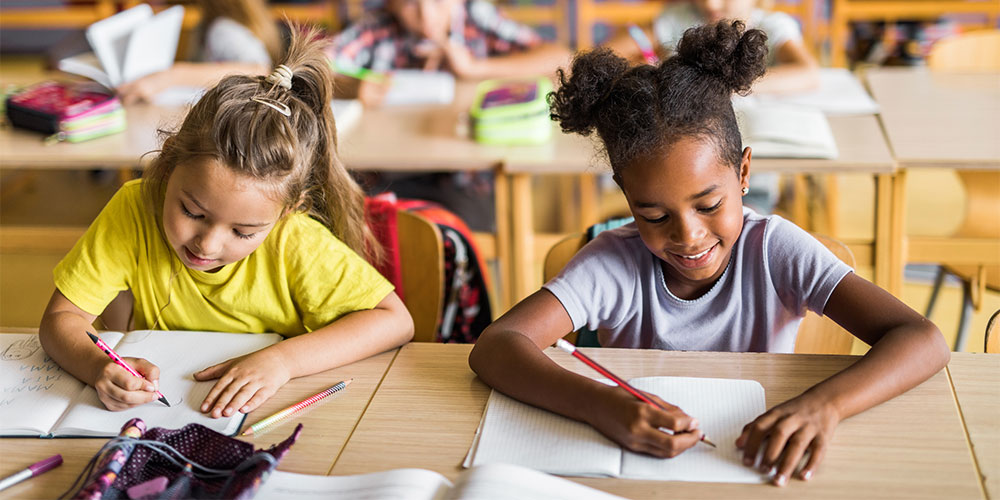Written communication is an important part of the way our society interacts with one another. Even if you don’t have plans to be a writer, at some point you’ll have to write a college essay, an email, a Facebook post, a letter of recommendation, the list goes on. That’s why school is full of written assignments as early as elementary school. The earlier students learn to communicate their thoughts and feelings through writing, the easier they can navigate communication and relationships with other people as a whole.
But writing isn’t just a tool to help students learn communication skills. When taught well, writing can be a creative outlet for students, a chance to express themselves and play with their imagination or their use of language. Writing can even be fun, something that students look forward to at the beginning of the day.
Why Joyful Writing?
Any teacher who has taught elementary students knows that it can be a challenge to hold their interest, especially in the days since the COVID-19 pandemic began. The best way to get elementary school students interested in writing is to emphasize the joyful aspect of writing. That, when done right, writing can be another way of painting or choosing their favorite outfit — a way of expressing themselves. When shared together, writing can be a social act for elementary students as well as a form of expression.
Joyful writing can help elementary students:
- Choose writing topics that play on their strengths and improve their weaknesses
- Learn how to collaborate with their classmates in projects that include multiple authors
- Practice self-reflection and mindfulness
- Improve their self-esteem as their writing skills grow and they share their writing with others
Writing Classroom Activities For Elementary Students
There are plenty of benefits to joyful writing in the classroom. The next question is how to engage your students in joyful writing. As is often the case with elementary students, one of the best ways to do that is through games and activities. Here are a few that we recommend:
Poetry Mad Libs
Getting a classroom full of elementary students interested in poetry can be a challenge, but poetry mad libs is a fun and silly way to teach them the structure of poetry or the importance of word choice.
First, take a poem and remove several of the adjectives, adverbs, nouns, and verbs. From there, treat it like any other game of mad libs. Ask your students to offer up the first words that come to mind for each category. The wackier the words, the better the end result. You could end up with a result like “a dress made of mouse traps,” but in a subtle way, the silliness of the mad libs will acquaint your students with the rhythm and formula of poetry.
Classroom Freewriting
Freewriting is a relaxing way for students to stretch their writing muscles and get a sense of their style and voice. It involves sitting down for a set period of time, given one simple prompt, and simply writing continuously for the whole period. Students can write whatever comes to mind, so often freewriting can become very stream-of-consciousness. As we’ve discussed in the above-linked blog, freewriting can help to:
- Relax the mind by taking some of the pressure off of writing. The point is simply to write continuously, with no expectations.
- Exercise creativity as students work to come up with writing ideas and to keep writing throughout the entire freewriting period.
- Build confidence especially where their ability to write is concerned.
Freewriting comes with a prompt, which you can work in with other classroom lessons or come up with specifically for the exercise. You might include prompts like:
- Write a story about a painting, such as Starry Night
- Pretend that a robot lives in your house
- Which planet is your favorite, and why?
- What would you ask your dog if they were suddenly able to talk?
- What would life be like without the internet?
Pursuing Dreams
Not every elementary student knows about the dream job that they want, but they likely have some idea of what they want to be when they “grow up.” It might be the house they want to live in or the things they want to do for fun, or it might be the career they imagine themselves having. Encourage your students to write about these things. Writing about the dreams that bring them joy will help them to feel more joyful themselves.
As Student Resources explains in their blog, “Asking your students to write about their dream jobs can be an excellent opportunity to help them practice using different research tools, hone their critical thinking skills, or simply inspire them—not only to consider their dreams in depth, but to begin figuring out how to make them come true.”
Collaborative Writing
You can also engage students in writing through collaborative storytelling. Start with a blank sheet of paper and ask the first student to begin writing. It might be that they will write one sentence or write for one minute, or some equivalent. Once they’re finished, they will pass the paper to the student behind them, who will add to the story. By the end of the game, the entire class will have contributed and you can read the story aloud to share the finished result. The story is bound to get some giggles, and it will teach students to collaborate as well as express themselves through writing.







